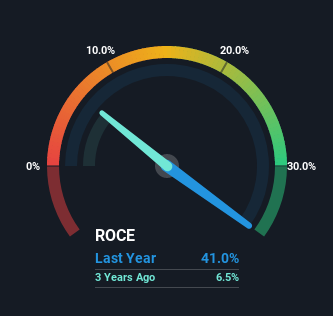Tree Island Steel (TSE:TSL) Is Very Good At Capital Allocation
If you're not sure where to start when looking for the next multi-bagger, there are a few key trends you should keep an eye out for. Firstly, we'd want to identify a growing return on capital employed (ROCE) and then alongside that, an ever-increasing base of capital employed. This shows us that it's a compounding machine, able to continually reinvest its earnings back into the business and generate higher returns. So when we looked at the ROCE trend of Tree Island Steel (TSE:TSL) we really liked what we saw.
Understanding Return On Capital Employed (ROCE)
If you haven't worked with ROCE before, it measures the 'return' (pre-tax profit) a company generates from capital employed in its business. To calculate this metric for Tree Island Steel, this is the formula:
Return on Capital Employed = Earnings Before Interest and Tax (EBIT) ÷ (Total Assets - Current Liabilities)
0.41 = CA$60m ÷ (CA$215m - CA$67m) (Based on the trailing twelve months to March 2022).
Therefore, Tree Island Steel has an ROCE of 41%. That's a fantastic return and not only that, it outpaces the average of 2.4% earned by companies in a similar industry.
See our latest analysis for Tree Island Steel
Historical performance is a great place to start when researching a stock so above you can see the gauge for Tree Island Steel's ROCE against it's prior returns. If you're interested in investigating Tree Island Steel's past further, check out this free graph of past earnings, revenue and cash flow.
So How Is Tree Island Steel's ROCE Trending?
The trends we've noticed at Tree Island Steel are quite reassuring. The data shows that returns on capital have increased substantially over the last five years to 41%. Basically the business is earning more per dollar of capital invested and in addition to that, 68% more capital is being employed now too. This can indicate that there's plenty of opportunities to invest capital internally and at ever higher rates, a combination that's common among multi-baggers.
On a related note, the company's ratio of current liabilities to total assets has decreased to 31%, which basically reduces it's funding from the likes of short-term creditors or suppliers. Therefore we can rest assured that the growth in ROCE is a result of the business' fundamental improvements, rather than a cooking class featuring this company's books.
The Key Takeaway
A company that is growing its returns on capital and can consistently reinvest in itself is a highly sought after trait, and that's what Tree Island Steel has. And investors seem to expect more of this going forward, since the stock has rewarded shareholders with a 52% return over the last five years. So given the stock has proven it has promising trends, it's worth researching the company further to see if these trends are likely to persist.
One final note, you should learn about the 3 warning signs we've spotted with Tree Island Steel (including 1 which is a bit unpleasant) .
If you'd like to see other companies earning high returns, check out our free list of companies earning high returns with solid balance sheets here.
Have feedback on this article? Concerned about the content? Get in touch with us directly. Alternatively, email editorial-team (at) simplywallst.com.
This article by Simply Wall St is general in nature. We provide commentary based on historical data and analyst forecasts only using an unbiased methodology and our articles are not intended to be financial advice. It does not constitute a recommendation to buy or sell any stock, and does not take account of your objectives, or your financial situation. We aim to bring you long-term focused analysis driven by fundamental data. Note that our analysis may not factor in the latest price-sensitive company announcements or qualitative material. Simply Wall St has no position in any stocks mentioned.

